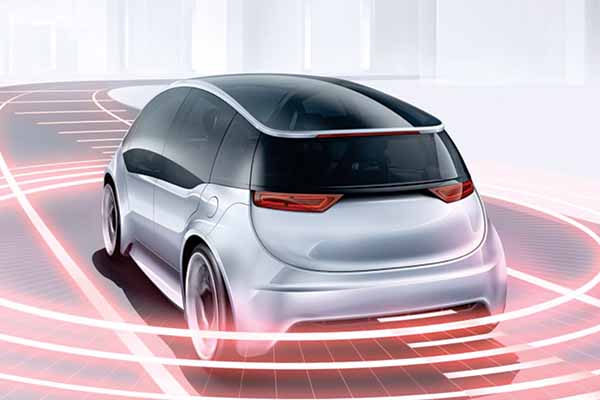The automotive industry has been going through a straining time due to the pandemic. Post the pandemic worst hit was the supply chain and semiconductor shortage logjam. Also, the volatile global economic situation has been impacting the overall vehicle sales and has put the car market under close look of improvisation. Latest technology and advanced processes have been also keeping the automotive industry on the brink of reassessment. Meanwhile, the ADAS (Advanced Driver Assistance Systems) market has been a significant contributor to the growing automotive industry. OEMs and value chain partners are investing massively into the research and development of ADAS. Hence new product launches and newer roadmaps have been further contributing to the growth of ADAS (Advanced Driver Assistance Systems) and customers are well accepting the ADAS-Front tech evolution. They reduced large investments in level (L) 4 autonomous development and rerouted investments to assisted and piloted driving to gain short-term returns. Today it is vital to state that every global automaker is making prominent and significant strategies to become a leader in the ADAS space/technology. General Motors, Volvo, Toyota, Ford, Volkswagen, Tesla, BMW, and Audi, to name just a few have been staring dominance in the ADAS industry. Meanwhile, the global ADAS market is expected to grow from $26.99 billion in 2021 to $31.36 billion in 2022 at a compound annual growth rate (CAGR) of 16.17%. The ADAS market is expected to reach $57.77 billion in 2026 at a CAGR of 16.51%. This indeed seems to be a fortifying future defining the future of the automotive industry, all thanks to autonomy preferably ADAS. To define further ADAS (Advanced Driver Assistance Systems), the new automobile has advanced tire pressure monitoring system (TPMS), drowsiness monitor system, intelligent parking assist system (IPAS), adaptive cruise control system, blind spot object detection system, lane departure warning system, adaptive front-lighting system etc.
ADAS (Advanced Driver Assistance Systems) – The Defining Year of Hardware and Software
The new ADAS is a wonderful coupling of hardware and software which significantly controls the vehicle towards enhanced user assistance and provides spectacular features in passenger vehicles, commercial vehicles, buses, and trucks. Various chips power autonomous application solutions in automotive. Chips like SoCs (systems on a chip) have been playing an instrumental role to propel ADAS further. These SoCs further interconnect sensors to actuators through interfaces and high-performance ECUs (electronic controller units).

The advanced part of ADAS is Self-driving cars which use these technologies and added a self-learning motion for driving a car. Sometimes defined as 360-degree vision, both near (in the vehicle’s immediate vicinity) and far. Hence to meet these transformations, hardware designers are using advanced process nodes to meet ever-higher performance targets while simultaneously reducing demands on power and footprint.
Essential Safety-Critical ADAS Applications Include:
- Pedestrian detection/avoidance
- Lane departure warning/correction
- Traffic sign recognition
- Automatic emergency braking
- Blind spot detection
According to key leaders in the ADAS domain, they reckon the shift from distributed ADAS electronic controller units (ECUs) to a more integrated ADAS domain controller with centralized ECUs is the potential future. We are currently at what SAE International designates as Level 2 (Partial Driving Automation), where the vehicle can control both steering and accelerating/decelerating but falls short of self-driving because a human sits in the driver’s seat and can take control of the car at any time. Also, ADAS comprises an adaptive front-lighting system which are electronics or sensor-based systems defining lights depending on vehicle speed and steering input.
Contributors and Regulation for ADAS
Common Passive ADAS Functions Include:
- ABS – Anti-lock Braking Systems: Keep the car from skidding and turning when emergency braking is applied.
- ESC – Electronic Stability Control: Assists the driver in avoiding under or over-steering, especially during unexpected driving conditions.
- TCS – Traction Control System: Incorporates aspects of both ABS and ESC above, to assist the driver in maintaining adequate traction when negotiating turns and curves.
- Back-up Camera: Provides the driver a view behind the car, when parking or backing up.
- LDW – Lane Departure Warning: Alerts the driver if the vehicle is not keeping within its lane.
- FCW – Forward Collision Warning: Tells the driver to brake in order to avoid a collision ahead.
- Blind Spot Detection: Warns the driver that there is a vehicle in their blind spot.
- Parking Assistance: Warns the driver when their front or rear bumpers are approaching an object at low speeds, i.e. when manoeuvring into a parking space.
Key contributors driving the ADAS market have been North America, though, Asia and Europe are also revving up towards the growth and adoption of ADAS. Technological advancements are a key trend gaining popularity in the ADAS market. Major companies operating in the ADAS market are focused on developing new technological solutions to strengthen their position through the implementation of next-generation ADAS technologies into their products such as sensor fusion, embedded vision, HMI, software infrastructure, and autosar. The increasing government regulations for mandatory ADAS implementation in vehicles are propelling the advanced driver assistance systems market. Governments across the globe are implementing mandatory ADAS inclusion regulations in the vehicle to strengthen driving convenience and safety of the drivers and commuters. For instance, in May 2019, The European Regulation adopted a new regulation No.2019/2144 that requires all vehicle manufacturers across the EU to incorporate ADAS into their new vehicles starting from mid-2022. This regulation was focused on increasing the general safety of motor vehicles and protection of vehicle occupants, and vulnerable road users, in a move to decrease the number of road accidents. Therefore, the increasing regulations for mandatory implementation of ADAS in vehicles are driving the growth of advanced driver assistance systems.
Where is India in ADAS?
The Indian automobile industry is today undeniable on the global stage as it is a major contributor to the Indian economy. Though the ADAS is quite in a nascent stage and only a few companies offer the ADAS technology. Reports suggest that many Indian automakers are eyeing big into the indigenous ADAS market as it plans to work closely to formulate lower levels (1-2) of driving autonomy classification.
Safety is key to the growth of automotive in India. India faces the worst road accidents in the world stating the country to have lesser driving and road sense. The government has been trying to bring policies and infrastructure targeting zero fatalities due to road accidents. To be fair, India has a big population and a large number of vehicles on road, but the adoption of safety-related regulations and technology is very important to improve our road safety standards.
India drives the world in rush hour gridlock-related passing and a few Indian residents have endured lethal car crashes lately. Be that as it may, they are normally determined quick, wildly, and without thought to the guidelines of the street. Indeed, even the primary streets every now and again have just two paths, with poor perceivability and deficient admonition markers.
Challenges, For instance, the computerized path flight avoidance framework may carry alongside a sentiment of loss of control to the driver, leaving vulnerability about what their job is in responding fittingly to the mechanized reaction and perhaps worried by a surprising mediation. The Locus of control is an individual view about how outer powers impact and control occasions in an individual’s life. It is resolved by the degree to which a driver properties his/her activity as liable for the conduct of the vehicle (inside locus of control), contrasted and the computerized framework activity (outer locus of control). It is probably not going to remove the driver from the circle right away, in light of the fact that drivers won’t totally give up in side control, or that the foundation won’t be grown adequately to completely self-ruling vehicles.
In the event that the inward control is excessive, the ADAS framework won’t be considered proficient and the outstanding burden of the driver is still high.
Most importantly, framework planners need to consider all the issues in planning the up-and-coming age of the ADAS framework, presumably, some parity must be estimated, and exchange-offs must be made among usefulness and ease of use.
Working Modes for Challenges
An ever-increasing number of individuals understood the advantage to set ADAS working in various modes to receive diverse driving circumstances. As proposed, an electronic driving help framework can be considered to work in various modes, from hesitant data supply by means of dynamic help at the driver’s will to leaving control of innovation totally. Structuring ADAS is consequently, not just went up against the negligible execution of trend-setting innovations, however, and should address suggestions for human activity too. A client-focused way to deal with the structure includes discovering as much as you can about the focus on clients and afterwards utilising this data when planning.















